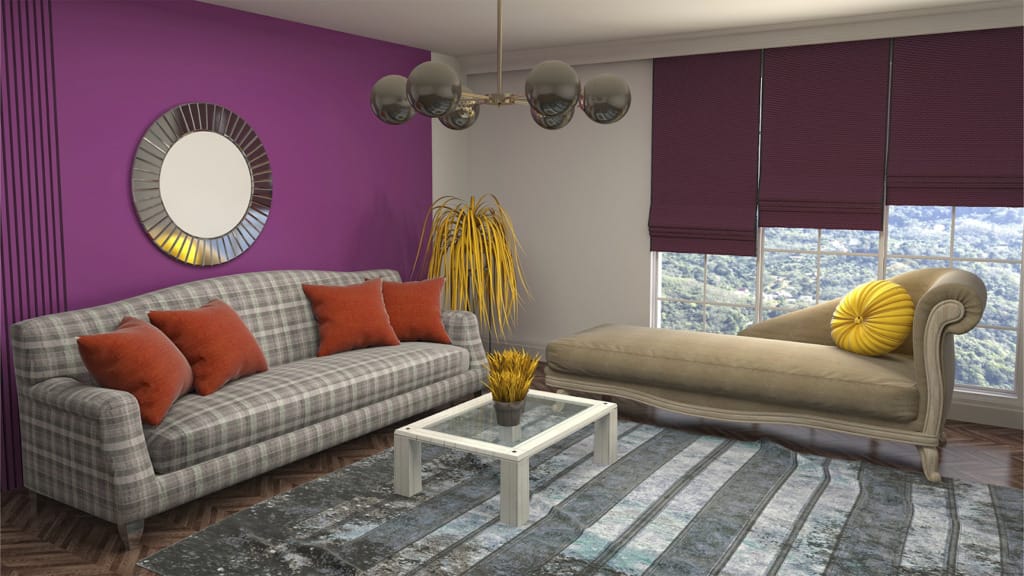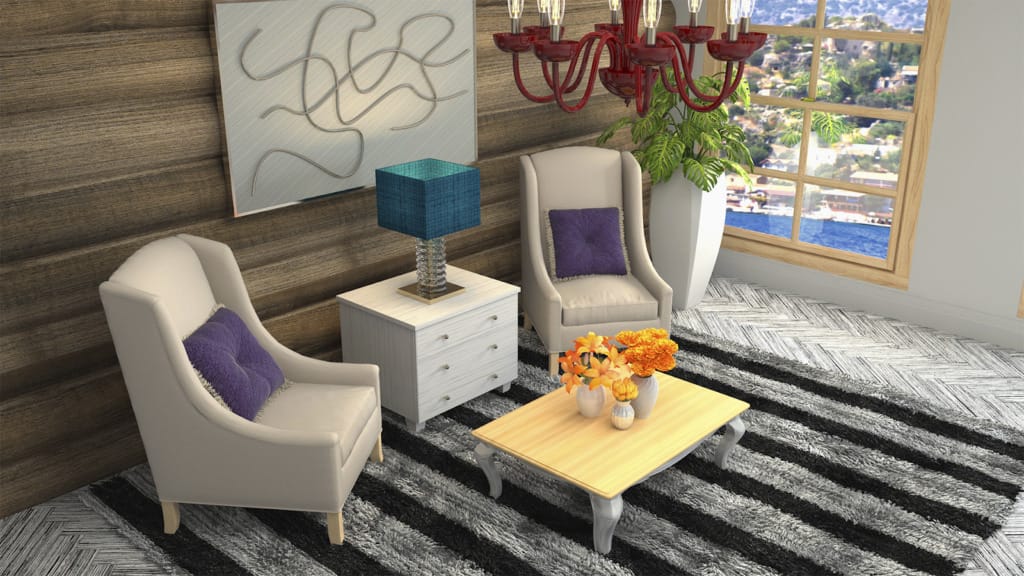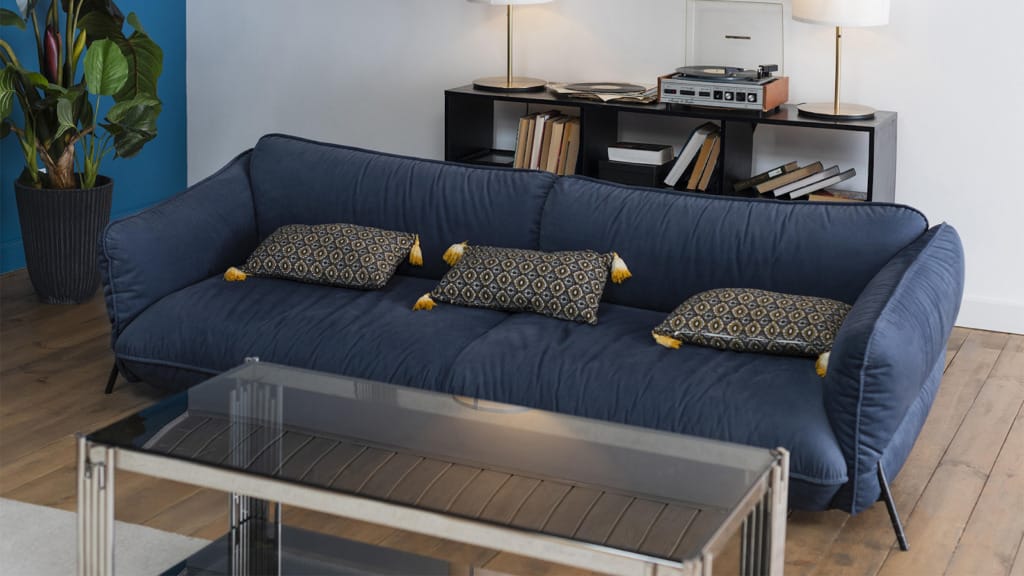Renting furniture is a smart way for homeowners and investors to elevate a property’s appeal without a full renovation. But one key question remains: should the furniture style match the home’s architecture? In most cases, yes. When furniture complements a home’s structure and era, it creates visual harmony, boosts perceived value, and helps buyers imagine living there. Mismatched styling, on the other hand, can feel off-putting and raise doubts about the property’s condition.
Think back to a home tour where everything felt “just right.” That seamless vibe comes from furniture, lighting, and accessories echoing the home’s architectural lines and materials. A modern sectional in a Victorian or a rococo sofa in a mid-century ranch? Jarring. It can make buyers question the seller’s understanding of the home, and even suspect hidden issues.
In this guide, we’ll explore why architecture-appropriate furniture matters, how to identify your home’s style, and which rental collections pair best with different structures. Plus, you’ll get tips for blending in modern touches, staying on budget, and avoiding common staging mistakes. Don’t miss the quiz and checklist at the end to make sure your staging hits the mark from curb to parlor.

Why Architectural Alignment Matters When Renting Furniture
A home’s architectural style shapes everything from room flow to ceiling height. When rental furniture reflects these structural cues, it creates a cohesive story that links curb appeal to interior ambiance, helping buyers form an emotional connection.
There’s also a practical upside: architecture-aligned staging makes rooms feel more spacious and balanced. In craftsman homes, built-ins, wood finishes, and exposed beams pair naturally with mission-style tables and earth-tone sectionals. Mid-century modern spaces shine with low-profile sofas, tapered legs, and bold lighting that echo their clean lines and organic forms.
And yes, it pays off. Homes that feel authentic and well-styled tend to sell faster and for more. Buyers aren’t just purchasing space, they’re buying a lifestyle. When your staging honors the home’s heritage, it signals care and thoughtful updates.
Step 1: Identify Your Home’s Core Architectural Style
Before you start sourcing rental furniture, take a moment to identify what architectural category your home falls into. Many houses blend influences, but you can usually discern a dominant style by looking at exterior details, floor plans, and original materials.
Craftsman / Prairie
Craftsman and prairie homes (early 20th century) feature natural wood, built-ins, fireplaces, and exposed beams. Stick to simple, sturdy furniture in warm woods and earth tones, think mission-style tables, brown leather sofas, and bronze lighting. Avoid ornate pieces; instead, highlight craftsmanship with handwoven textiles and hammered metal. For more inspiration, check out our guide on Craftsman home staging ideas.
Mid-Century Modern
Built between the 1940s and 60s, these homes favor open layouts, large windows, and indoor–outdoor flow. Use low-profile sofas, teak sideboards, sputnik chandeliers, and sculptural chairs. Earthy tones like mustard, olive, and burnt orange work well against neutral backdrops. Skip Victorian flourishes, they clash with the clean aesthetic.
Victorian / Edwardian
Known for ornate moldings, high ceilings, and bay windows, these homes call for elegant touches. Tufted settees, carved tables, and jewel-tone rugs fit the vibe. Add lace linens, antique mirrors, and dark trim for period charm, but avoid clutter. Choose classic silhouettes like wingbacks and pedestal tables, then modernize with fresh fabrics and simplified patterns.
Modern Farmhouse
This style blends rustic charm with clean lines, think exposed beams, shiplap, and stone. Use slipcovered sofas, distressed wood tables, and industrial lighting in black or bronze. Layer jute rugs, cotton throws, and warm neutrals like white, gray, and muted earth tones. If you’re tackling a mixed-era home, our post on choosing transitional furniture for mixed-era homes offers more tips.
Industrial Loft
Lofts feature open layouts, high ceilings, and exposed brick or ductwork. Stick to neutral palettes, white, gray, black, brown, and materials like metal, leather, and reclaimed wood. Edison bulbs, minimalist seating, and graphic lines enhance the industrial vibe. Soften the space with cozy textures like linen or weathered leather to avoid a cold feel.
Coastal / Transitional
Coastal homes embrace light, airy spaces with natural textures and beachy hues, driftwood, pale blues, and faded greens. Use slipcovered seating, whitewashed tables, and jute rugs. Transitional style blends traditional and modern elements, making it ideal for mixed architecture. Pair rolled-arm sofas with sleek tables or farmhouse pieces with modern chairs for a balanced look.
Step 2: Map Rental Catalog Styles to Architecture
Once you’ve identified your home’s dominant architecture, browse rental catalogues for collections that align. Most companies group furniture into modern, traditional, rustic, and transitional styles. Here’s how to match them:
- Craftsman / Prairie: Choose rustic traditional collections with earth-tone sectionals, mission-style tables, and bronze or oil-rubbed lighting. Skip sleek or glass-heavy pieces, they feel too modern.
For more inspiration, check out our guide on Craftsman home staging ideas. - Mid-Century Modern: Go for modern or mid-century collections. Look for low-profile sofas, teak sideboards, geometric chairs, and arc lamps. Sputnik chandeliers or globe pendants add flair.
- Victorian / Edwardian: Opt for classic or traditional collections, tufted sofas, wingbacks, ornate mirrors, and pedestal tables. Balance the elegance with modern pillows or contemporary art to avoid a dated look.
- Modern Farmhouse: Select farmhouse or rustic modern collections. Reclaimed wood tables, slipcovered sofas, barn-door cabinets, and metal pendants work well. Stick to neutrals with black accents. If you’re tackling a mixed-era home, our post on choosing transitional furniture for mixed-era homes offers more tips.
- Industrial Loft: Choose industrial or loft collections. Combine metal frames, leather seating, reclaimed wood, and exposed-bulb lighting. Add warmth with natural textiles to soften the raw aesthetic.
- Coastal / Transitional: Coastal collections feature slipcovered sofas, rattan chairs, whitewashed tables, and jute rugs. Transitional pieces, neutral colors, simple silhouettes, blend easily with any style and help bridge mixed eras.
Think beyond style, consider how the space is used. A craftsman home may need a solid wood dining table for gatherings, while a loft benefits from modular sectionals for flexible entertaining. Mixing collections is totally fine if it creates the right balance.
Step 3: Use the 80/20 Rule, 80% Harmony, 20% Contrast
Even in historic homes, you don’t want every piece to scream “period drama.” A perfectly matched room can feel contrived or dated. Interior designers often follow the 80/20 rule: keep 80% of the furniture aligned with the architecture, and 20% contrasting to introduce freshness. In a Victorian home, the 80% might include tufted sofas and carved sideboards. The 20% could be a sleek floor lamp or abstract art. This blend keeps the staging timeless and avoids museum fatigue.
In a mid‑century home, the majority of pieces might be authentic to the era, think wooden credenzas and low sofas, while the remaining 20% could feature a contemporary accent chair or statement rug. For a modern farmhouse, most items might lean rustic, with a few polished metal accents or minimalist decor items sprinkled in. The rule of contrast allows you to incorporate current trends without overwhelming the architecture.

Top 5 Architecture‑Friendly Rental Packages
Not sure where to start? Here are five curated packages that align with the most common architectural styles. Each collection offers a complete room solution with large anchor pieces, complementary accents, and appropriate lighting. Use these ideas as a blueprint when browsing rental catalogs.
Craftsman Warmth: Earth‑Tone Sectionals, Mission Coffee Tables, Bronze Lighting
To highlight a craftsman home’s warmth, choose a sectional in a chocolate or olive hue. Pair it with a sturdy mission-style coffee table, wooden sideboards, and bronze lighting. Add earth‑tone throw pillows and a handwoven wool rug to echo the natural materials inherent to the style. A floor lamp with a stained‑glass shade adds a vintage touch without looking dated. Finish with potted plants to soften all the wood.
Mid‑Century Cool: Low‑Profile Sofas, Teak Accents, Sputnik Pendants
For a mid‑century property, rent a low‑profile sofa with tapered legs in a neutral fabric. Complement it with teak side tables, a sculptural coffee table, and a sputnik pendant or arc floor lamp. Keep the color scheme earthy, rich greens, mustard, and burnt orange, and let one or two pieces make a statement, such as a lounge chair with a matching ottoman. Don’t forget a bold art print or geometric rug to tie the room together.
Victorian Elegance: Tufted Settees, Ornate Mirrors, Jewel‑Tone Rugs
Victorian staging calls for elegance. Choose a tufted settee or sofa, maybe in velvet, and pair it with carved wood coffee and side tables. Hang an ornate mirror above the fireplace or sofa to reflect light and make the room feel larger. Lay a jewel‑tone rug, ruby, sapphire, or emerald, under the seating area. Balance the old-world feel with a modern accent lamp or sleek accent chair, using the 80/20 rule. Embroidered curtains or lace table runners reference the period without overwhelming the room.
Coastal Airy: Slipcovered Seating, Whitewashed Tables, Jute Textures
In a coastal or transitional home, aim for a relaxed, breezy vibe. Slipcovered sofas and armchairs create an informal, beachy feel. Whitewashed coffee tables and sideboards keep things light. Layer jute or sisal rugs for texture, and bring in rattan or bamboo accent chairs. Keep the palette neutral with soft sand tones, pale blues, and crisp whites. For coastal properties in cooler climates, incorporate warm metals like brushed brass to prevent the space from feeling cold.
Industrial Edge: Leather Seating, Metal Frames, Edison‑Bulb Fixtures
For industrial lofts, start with a worn leather sofa or sectional. Add metal-framed coffee and side tables, perhaps with reclaimed wood tops. Include bar stools with castor wheels or industrial-style shelving units. Use floor lamps or pendant lights featuring exposed Edison bulbs and black metal shades. Balance the rawness with a plush area rug and a few plants to introduce color and warmth.
Neutral Foundations vs. Statement Accent Pieces
A common strategy among professional stagers is to keep foundational pieces neutral while using smaller accents to reference the architecture or add a pop of color. Neutral sofas, dining tables, and area rugs provide a versatile backdrop that appeals to a broad audience. They allow buyers to focus on the home’s features, like the craftsman woodwork or the industrial windows, rather than being distracted by bold patterns or colors.
Once the foundation is set, bring in accent pillows, art, throw blankets, and small accessories to nod to the home’s era. For a Victorian, jewel‑tone pillows and crystal accents evoke period opulence. In a mid‑century space, a geometric throw or abstract art print can infuse the era’s playful spirit. Modern farmhouse homes benefit from woven baskets and galvanized metal decor, while coastal properties come alive with ocean‑inspired artwork and airy linen textiles. By confining stylistic flourishes to easily changeable elements, you ensure the staging feels cohesive yet adaptable.
Common Mistakes: Mismatched Eras & Buyer Confusion
Staging can go awry when the furniture style clashes with the architecture. Here are some pitfalls to avoid:
- Mixing incompatible eras. A sculptural modern sofa in a Victorian living room or a baroque armoire in a mid‑century ranch throws buyers off. They may question whether the space has been renovated with respect to its heritage.
- Overcrowding rooms. Even in large homes, too much furniture makes spaces feel cramped. Buyers crave openness and the ability to visualize their own belongings. Rent only what you need to define the space and leave ample room for traffic flow.
- Ignoring buyer demographics. Consider who is most likely to purchase the property. A downtown loft may attract young professionals who appreciate industrial chic, while a suburban craftsman might appeal to families seeking warmth and tradition. Tailor your staging accordingly.
- Using mismatched color temperatures. Light bulbs with different color temperatures can create a disjointed atmosphere. Stick to consistent warm or cool lighting throughout a space.
- Blocking windows or architectural details. Don’t place a high-backed sofa in front of a bay window or a tall shelf against a decorative fireplace. Let the home’s unique features breathe.
Quick Quiz: Does Your Rental Plan Pass the Curb‑Appeal Test?
Want to test whether your rental plan aligns with your home’s architecture? Answer the following questions:
- Can someone identify your home’s architectural style from the street? If not, consider adding exterior staging, like period‑appropriate porch furniture or modern planters, to strengthen the theme. For more ideas, read our tips on curb appeal staging from porch to parlor.
- Does the interior color palette echo the exterior materials? For example, if your craftsman uses warm wood and stone, do your furnishings reflect those tones? If your home is clad in crisp white siding, is there a similar lightness indoors?
- Are your anchor pieces (sofas, beds, dining tables) aligned with the home’s era? They don’t need to be antiques, but they should reference the style’s proportions and materials.
- Did you incorporate at least one contrasting element? A room that’s too perfectly matched can feel sterile or outdated. A modern light fixture in a Victorian room or a rustic stool in a mid‑century dining area can add personality.
- Would your ideal buyer feel comfortable living here? Put yourself in their shoes: does the staging tell the story they want to live? If not, adjust your plan to better reflect their aspirations.
If you answered “no” to any of these questions, revisit your rental selections or consult a professional stager for guidance.
Final Checklist & Next Steps
Staging your home with rental furniture that complements its architecture is both an art and a science. Here’s a quick checklist to ensure you’ve covered all bases:
- Identify your home’s primary architectural style.
- Research furniture collections that align with that style.
- Apply the 80/20 rule: keep most pieces era‑appropriate and introduce a few contrasting accents.
- Choose neutral foundations and strategic accent pieces.
- Avoid common staging mistakes such as mismatched eras, overcrowding, and inconsistent lighting.
- Review the curb‑appeal quiz to check your plan’s cohesion.
For a more in‑depth consultation, download our printable staging checklist (available on our website) or schedule a personalized session with The Staging Place. We’ll help you map out the perfect rental furniture style match for your home architecture and ensure your property shines in today’s competitive market.
FAQs
How closely must rental furniture match period mouldings and trim?
You don’t need exact replicas, but your furniture’s scale and material should complement the architecture. A craftsman bungalow with chunky wood trim looks best with substantial wood furniture, while a Victorian with delicate moldings can handle lighter, more refined pieces.
Can I blend modern art with traditional rental furniture?
Absolutely. In fact, mixing a few modern elements keeps historic homes from feeling stuffy. Just keep art sizes appropriate and colors that tie into the room’s palette.
What if the home has mixed architectural eras?
Identify the dominant elements and lean into them for most pieces. Then use transitional furniture to bridge the gap between styles. For instance, if your home combines mid‑century lines with farmhouse finishes, choose clean-lined furniture in warm woods and accent it with rustic accessories.
Are neutral sofas always the safest choice?
Neutrals appeal to a wide audience and serve as a blank canvas. You can still add color and personality through pillows, throws, and artwork without overwhelming the space.
How do I stay on budget while renting era‑appropriate pieces?
Prioritize the rooms that will photograph and show the best, living rooms, dining areas, and primary bedrooms. Invest in key pieces like a statement sofa or dining table. Supplement with budget-friendly accents from discount rentals or thrift shops. And remember, the goal is to create an impression, not furnish every inch.


